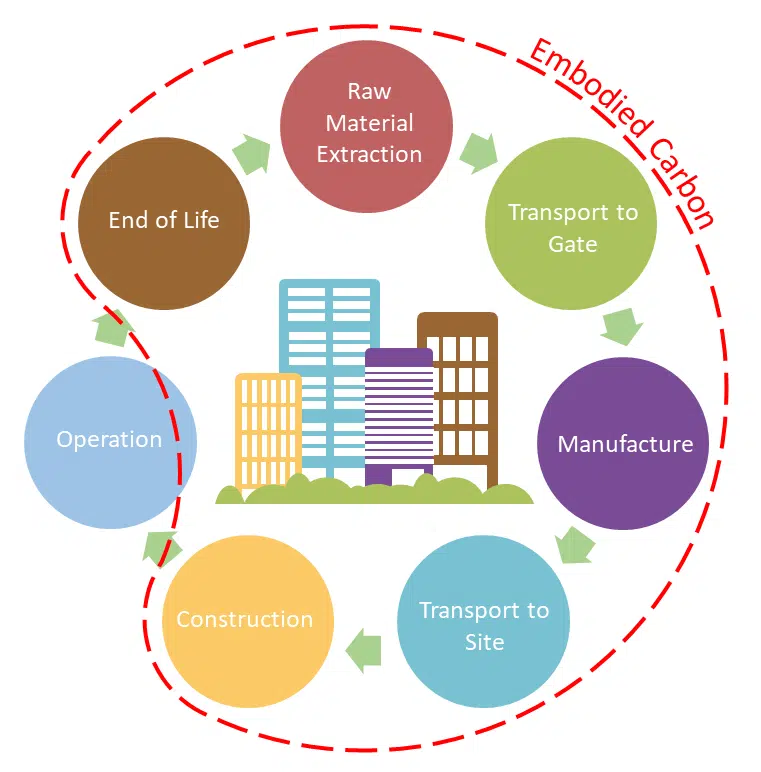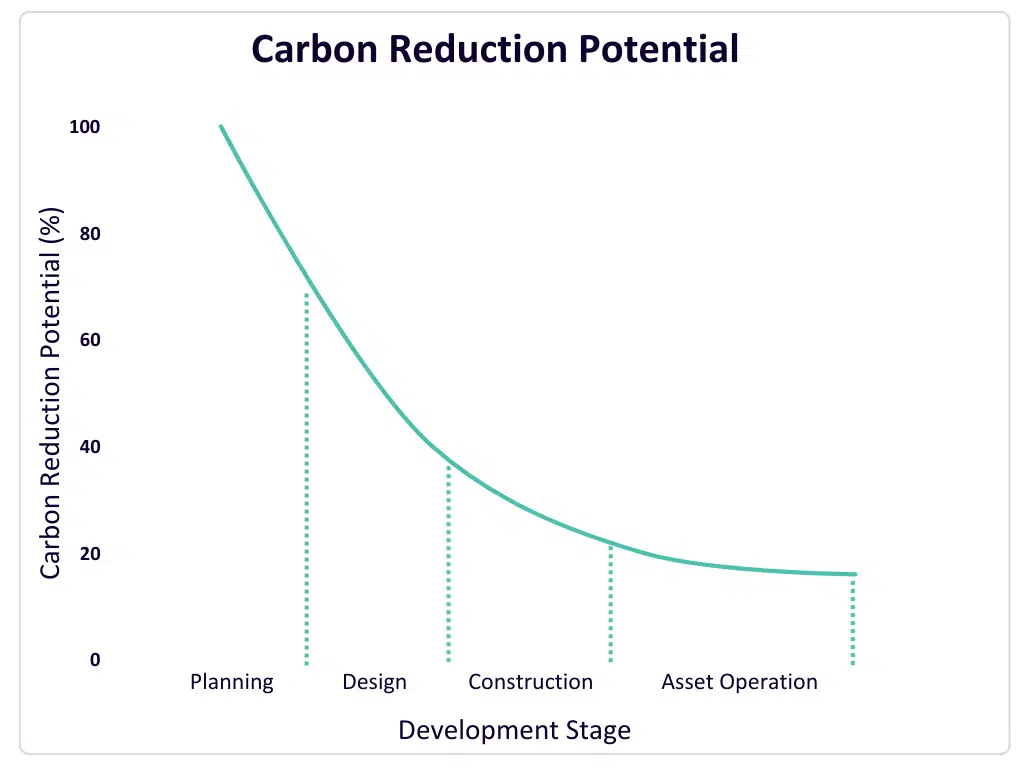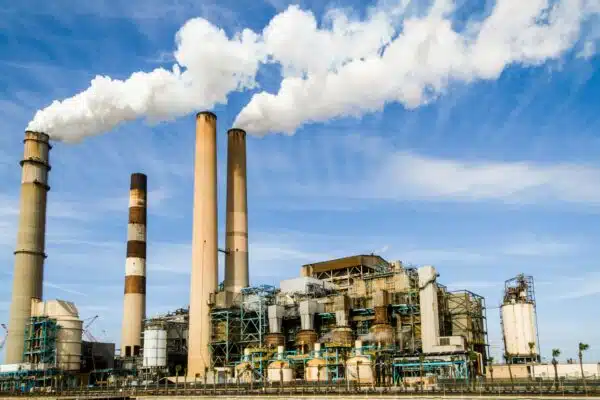There is increasing demand for whole life carbon assessments of building and construction projects, from a broad range of stakeholders, including clients, policy, legislation, investors and certification schemes.
What is a Whole Life Carbon Assessment (WLCA)?
A life cycle assessment (LCA) assesses the full life cycle impact of a product, activity or service against environmental impact categories, from cradle to grave.
A buildings Whole Life Carbon Assessment specifically assesses the full life cycle impact of a building. This can include any building type from a warehouse or factory to a house or block of flats. It can also be used to assess construction and civil engineering projects, such as roads, rail, water and energy infrastructure.
It is typically the sum of the embodied carbon, which is the carbon footprint to make and install materials, and the operational carbon, which is derived from the operational energy consumption over the lifetime of the building. This is shown in the diagram below, where the red line indicates the embodied carbon, and the whole life carbon also includes the operations.
What are the key drivers for undertaking a Whole Life Carbon Assessment?
There is an increasing demand for whole life carbon assessments of buildings and construction projects. They are also now needed earlier in the design process. Some of the key drivers include:
- BREEAM Credits: Mat 01 offers BREEAM credits for undertaking an LCA on your building project. There are multiple credits available, but to secure them, you need to undertake your first LCA at Concept Design (RIBA Stage 2) and submit to the BRE before a detailed planning application. This is a firm deadline and counts for most of the BREEAM Mat 01 credits, so it’s important not to miss it.
- Net Zero Carbon: For developments that wish to go Net Zero Carbon, they need an as-built embodied carbon report, to evidence the residual embodied carbon, after reduction measures, that would need to be offset, to achieve Net Zero Carbon Construction, e.g. the embodied carbon up to Practical Completion (PC). In a similar way, projects would also need an as-built LCA to go Carbon Neutral.
- Policy & Legislation: There are increasing requirements from local authorities on carbon measurement and reductions. One of the most detailed requirements is from the London Plan, which is applied in the Greater London Authority. Referable developments within the Greater London area, need to undertake Whole Life Carbon Assessments from Concept Stage, through to an as-built LCA. They have their own method and reporting templates.
What standards are applicable to whole life building LCAs?
They follow the European wide standard EN 15978:2011, which is a European wide standard on sustainability for construction works.
For projects in the UK, another relevant standard is the RICS professional statement on Whole Life Carbon Assessment, which now covers both buildings and infrastructure.
Building LCA’s still cover the same 20 impact categories as general LCA. Buildings WLCA’s are focussed purely on a single category, CO2e, for a more streamlined assessment, where greenhouse gas emissions reduction is the driving factor for undertaking the assessment.
It is also important to remember that unlike operational carbon emissions the embodied energy and carbon cannot be reversed. Once they have been released the opportunity for improvement has passed. The importance of understanding embodied carbon is therefore becoming clear and it can easily be reduced by 10-20% without increasing capital costs. As buildings energy performance improvements, embodied carbon becomes an even bigger proportion of a building’s overall impact.
What is typically included within an As-Built WLCA?
A whole life carbon assessment looks at the impact of the building through each of the EN 15978 life cycle modules (Modules A, B & C).
Materials and Products (Modules A1 – A4)
- The cradle – raw material extraction
- Transportation through the supply chain
- Material processing and fabrication, including the energy used to do so
- The finished products
- Transportation of finished products to the construction site
Construction (Module A5)
- The energy used on site during construction, including any demolition
- Construction waste impacts and waste transportation
Operation (Module B)
End-of-life (Module C)
- End-of-life of products and materials
In the UK, operational carbon is usually taken from the Building Regulations UK Part L (BRUKL) certificate, which all non-domestic new builds require. It covers the heating and lighting, but it doesn’t cover items such as the electricity to power other equipment, such as computers and machines. The embodied carbon of those items is not included. However, there is a noticeable shift towards more realistic, predictive energy modelling such as CIBSE TM54 modelling, which is specified by more modern Whole Life Carbon standards.
As-built WLCA’s are usually undertaken from cradle to practical completion (PC) of a building. WLCA’s often use data from Environmental Product Declarations (EPDS) but are often supplemented by data from embodied carbon databases, such as the ICE Database.
What are the benefits of conducting an As-Built WLCA?
The initial benefit of conducting a building WLCA is to understand and document the performance of the building which has been constructed, both from an embodied carbon and operational carbon perspective.
Depending on the stage that the WLCA has been undertaken at (design stage, construction or post-construction), the results of the WLCA can be used to assist with decision making for lower environmental impacts, on the same building, or as a reference point for future buildings and developments. If a building is looking to achieve a BREEAM rating, a high-level LCA is often conducted at concept design stage, this is known as a Mat01 assessment. The potential to reduce embodied carbon is always greater at the earlier stages of the project life-cycle, as illustrated below:
WLCA can be used to declare a building’s environmental performance, as well as used for marketing and certification of embodied and whole life carbon reductions.
Furthermore, WLCAs provide suitable evidence to confirm the amount of carbon required to be offset for a Net Zero Carbon Construction building, in line with the UKGBC Net Zero Carbon Framework.
A building WLCA could also be used to provide the key evidence to take a building through the Planet Mark for New Developments certification. This certification requires a building to be lower embodied and whole life carbon than that of a pre-defined baseline building, which can be shown through the results of a building WLCA.







